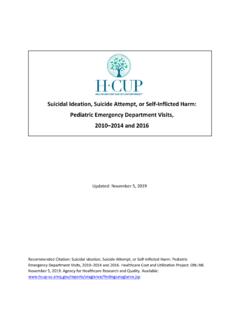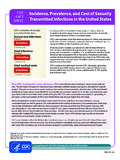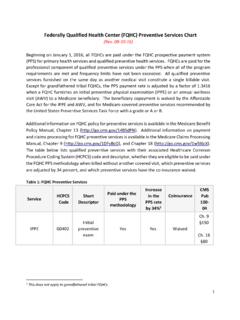Transcription of HEALTHCARE COST AND Agency for Healthcare UTILIZATION ...
1 HEALTHCARE COST AND Agency for HEALTHCARE UTILIZATION PROJECT Research and Quality STATISTICAL BRIEF #172. April 2014. Highlights Conditions With the Largest Number of In 2011, there were Adult Hospital Readmissions by Payer, approximately million adult 2011 30-day all-cause hospital readmissions in the United Anika L. Hines, , , Marguerite L. Barrett, , H. Joanna States, and they were Jiang, , and Claudia A. Steiner, , associated with about $ billion in hospital costs. Introduction For Medicare patients, the three Health care reform has pinpointed hospital readmissions as a key conditions with the largest area for improving care coordination and achieving potential number of 30-day all-cause Stakeholders are using data to devise strategies to readmissions were congestive reduce readmissions.
2 Two criteria for evaluating potential areas heart failure (134,500. of impact include volume and costs. For example, the Centers for readmissions), septicemia Medicare & Medicaid Services (CMS) Hospital Readmissions (92,900 readmissions), and Reduction Program has selected acute myocardial infarction, pneumonia (88,800. heart failure, and pneumonia as target areas for the Medicare readmissions). These conditions population. CMS chose these conditions, in part, because of their resulted in about $ billion in high prevalence and their associated high costs for total hospital costs.
3 Admissions and readmissions among Medicare In For Medicaid patients, the three 2015, CMS will expand their assessment of readmissions to conditions with the largest additional conditions that represent high volume and costs. number of 30-day all-cause readmissions were mood Identifying conditions that contribute the most to the total number disorders (41,600. of readmissions and related costs for all payers may aid health readmissions), schizophrenia care stakeholders in deciding which conditions to target to (35,800 readmissions), and maximize quality improvement and cost-reduction efforts.
4 This diabetes (23,700 readmissions). Statistical Brief uses readmissions data from the HEALTHCARE Cost These conditions resulted in and UTILIZATION Project (HCUP) to present the conditions with the about $839 million in hospital largest number of 30-day all-cause readmissions among costs. hospitals in 2011 and their associated costs. We limited the study population to Medicare beneficiaries aged 65 years and older and For the privately insured, the to individuals aged 18 64 years who were privately insured, three conditions with the largest uninsured, or covered by Medicaid.
5 We display the 10 conditions number of 30-day all-cause with the largest number of readmissions for each payer. readmissions were maintenance chemotherapy (25,500. Readmission was defined as a subsequent hospital admission readmissions), mood disorders within 30 days following an original admission (or index stay) that (19,600 readmissions), and occurred from January through November 2011. Patients were complications of surgical or followed across the same and different hospitals. All-cause medical care (18,000.)
6 Readmissions were examined; thus, readmissions may or may not readmissions). These conditions include conditions that were listed as the principal diagnosis resulted in about $785 million in during the index stay. Some readmissions may be planned or hospital costs. 1. Orszag PR, Emanuel EJ. Health care reform and cost control. New England Journal of Medicine. 2010;363(7):601 3. 2 Thorpe JH, Cascio T. Medicare Hospital Readmissions Reduction Program. Legal Notes. 2011;3(4):1 3. Accessed December 6, 2013.
7 1. unavoidable no attempt was made to remove these types of readmissions from this descriptive analysis. Readmission rates were calculated without risk Findings Overview of hospital readmissions and related costs by payer In 2011, there were approximately million readmissions in the United States across all payers in the study population (Table 1). Readmissions contributed $ billion in total hospital costs. Medicare had the largest share of total readmissions ( percent) and associated costs for readmissions ( percent).
8 Medicaid had the second largest share of total readmissions ( percent). and represented a lower share of associated costs ( percent). Private insurance had a much smaller share of total readmissions ( percent) and the second highest associated costs ( percent). The uninsured represented the smallest proportion of the hospital population overall, accounting for only percent of total readmissions and percent of costs. Overall, readmission rates per 100 admissions in this study population ranged from for the privately insured to for Medicare beneficiaries.
9 Table 1. Total all-cause, 30-day readmissions and aggregate costs for the study population by payer, 2011. Number of readmissions Cost of readmissions Readmission Number of Readmissions Total cost of Readmission total cost as a all-cause, as a all-cause, rate Study population percentage of 30-day percentage of 30-day (per 100. total cost of readmissions total study readmissions admissions). study (in thousands) population (in millions), $ population readmissions readmissions Medicare (65+ years) 1,800 24,000 Medicaid (18 to 64 years) 700 7,600 Privately Insured (18 to 64 years) 600 8,100 Uninsured (18 to 64 years) 200 1,500 Total 3,300 41,300 Source.
10 Weighted national estimates from a readmissions analysis file derived from the Agency for HEALTHCARE Research and Quality (AHRQ), Center for Delivery, Organization, and Markets, HEALTHCARE Cost and UTILIZATION Project (HCUP), State Inpatient Databases (SID), 2011. 3 Please note that the purpose of this study was to track the total number of readmissions and associated costs; therefore, risk adjustment was not included. This approach may differ from those employed by AHRQ and CMS when readmission rates are generated for the purpose of comparison.








